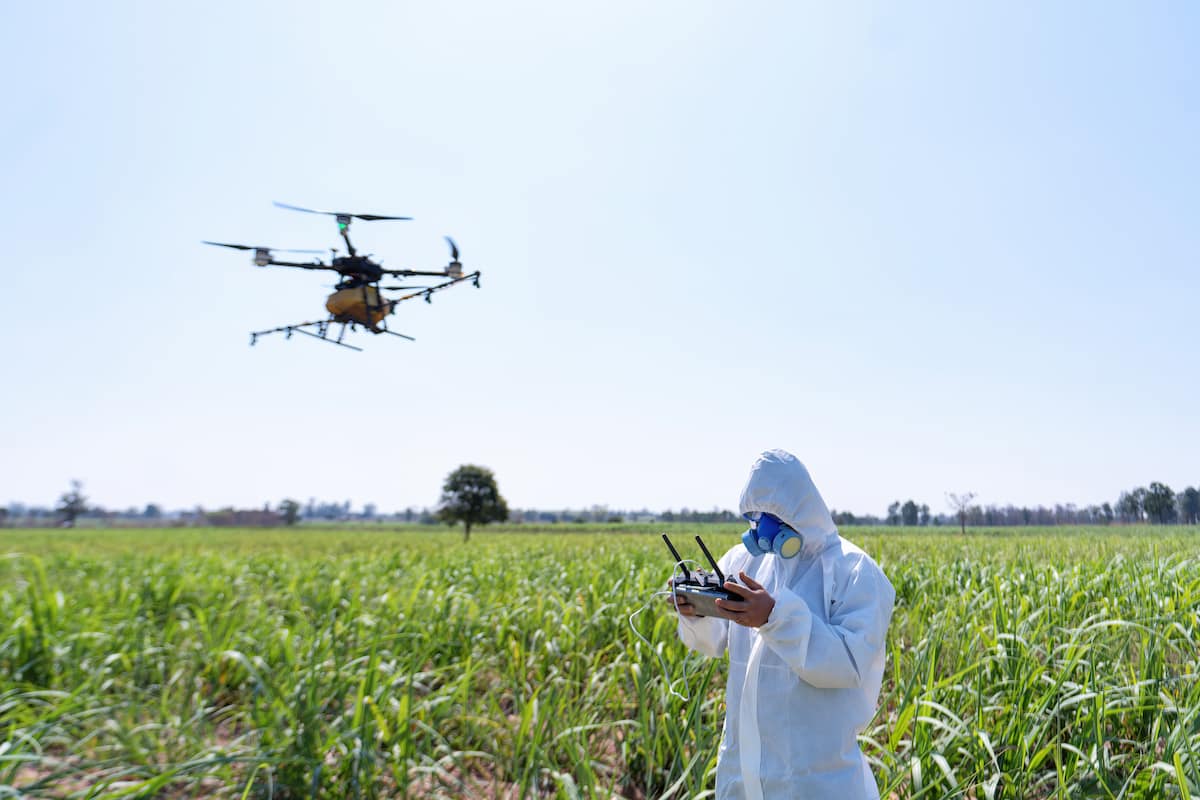Revolutionizing agriculture through precision farming, also called precision agriculture, involves harnessing technology to optimize crop production and minimize wastage. A report by the US Department of Agriculture reveals that implementing precision farming techniques can significantly increase farm profitability by up to 70%.

The technology contributes to environmental sustainability by reducing nutrient runoff into nearby water sources by up to 40%. The process involves using cutting-edge GPS, GIS, and remote sensing technologies to create precise farm maps and guide variable rate technology for applying fertilizers, pesticides, and seeds.
Basics of Precision Farming
What is Precision Farming?
Precision farming, or precision agriculture, is a modern farming technique that utilizes IoT devices such as GPS services, guidance systems, mapping tools, and variable rate technologies (VRT) to enhance crop productivity and quality. By collecting and analyzing data from the farm, farmers can identify areas of potential improvement and adjust their practices accordingly.
For instance, using soil moisture data, farmers can accurately determine their crops’ health or stress levels, enabling them to provide precise amounts of water, pesticides, and fertilizers. Precision farming can therefore help conserve resources and produce healthier crops, leading to increased profitability and sustainability in the long run.
What is the Need for Precision Farming?
- Precision farming can solve the negative environmental impacts of conventional farming.
- Agricultural inputs such as machinery, pesticides, and water contribute to environmental pollution.
- Factors like lack of knowledge and funds hinder the adoption of precision agriculture.
- Precision farming minimizes using fertilizers, pesticides, and herbicides, reducing farmers’ expenses.
- It improves crop productivity, prevents soil degradation, and promotes efficient water resource use.
- Growing growers can see significant cost reductions by using technology to apply components sparingly.
Components and Tools and Techniques of Precision Farming
Precision farming entails location-specific agricultural strategies that increase crop output while minimizing input costs, environmental, soil, water damage, and human health risks. GIS, GPS, remote sensing, variable rate technology, NDVI, nutrient expert systems, SSNM, bio-intensive farming, real-time nitrogen management, DRIS approach, soil testing, and yield monitoring are some of the tools and techniques that make this approach possible.
GIS is a computerized mapping system that overlaps different data layers, such as land use, irrigation management, crop, soil, and environment. The system comprises hardware, software, and methods for compiling, storing, retrieving, and analyzing feature attributes and position data to generate maps. GIS maps, for example, can highlight all areas with comparable characteristics, assisting researchers in determining where to explore more unusual plants.
GPS is a navigation system that uses a network of 24 satellites in space to assist users in properly recording positional information (latitude, longitude, and altitude). It enables detailed farm mapping and tells farmers about the status of their crops and which parts of the farm require what inputs, such as water, fertilizer, and pesticides.
Remote Sensing The study of obtaining information about items or places from a distance, generally from aircraft or satellites, is known as remote sensing. It is used to get information about an object without physically touching it. Aerial and satellite photography can be analyzed to provide vegetative indices that reflect plant health.
Variable rate technology (VRT) enables the application of farm inputs such as fertilizer, pesticides, lime, gypsum, and irrigation water at varied rates over a field. This technology extends from simple flow rate control to more intricate rate, chemical mix, and application pattern management. VRT may match changes in crop output potential to precise input rates, resulting in a more efficient system with fewer environmental implications.
NDVI, nutrient expert systems, SSNM, bio-intensive farming, real-time nitrogen management, DRIS method, soil testing, and yield monitoring are also precision farming components. These methods and practices have helped to increase crop productivity, lower production costs, and reduce environmental harm.
In case you missed it: The Agricultural Aspects of Cover Crops

Basic Steps in Precision Farming
Precision farming is a method that involves using advanced technologies to analyze variability in crops and provide specific recommendations for managing that variability. The three basic steps involved in precision farming are assessing variability, managing variability, and evaluating.
- The first step in precision farming is assessing variability. This involves quantifying the variability of factors that control crop performance regarding yield.
- Techniques for calculating spatial variability are widely available and used in precision agriculture. However, simultaneous reporting of both spatial and temporal variation is rare.
- The second step in precision farming is managing variability. This involves matching agronomic inputs to general conditions employing site-specific management recommendations, and use proper applications control equipment.
- Effective use of information can result in increased efficiency and avoids any wastage.
- The third step in precision farming is evaluation. This involves analyzing the profitability of precision agriculture, potential environmental improvements, and technology transfer.
- Precision agriculture can be profitable if the data is handled properly, and possible gains in environmental quality are frequently stated as justifications for employing it. Communication with farmers on managing spatial and temporal variability is part of technology transfer.
Advantages of Precision Farming
- Increases agricultural productivity by optimizing crop yields and addressing issues before they become significant problems.
- Reduces soil degradation through practices such as no-till farming and minimizing soil compaction and erosion.
- Reduces chemical application in crop production by targeting specific areas and adjusting application rates based on soil and crop conditions.
- Efficient use of water resources by applying water only where and when needed, reducing water wastage and improving crop yields.
- Encourages the adoption of modern farm practices, improving the quality and quantity, and reducing the cost of production.
- Offers opportunities for farmers to improve their socio-economic status by adopting modern practices, increasing farm efficiency and profitability, and accessing new markets.
- Plays essential in monitoring greenhouse conditions in agricultural fields to optimize crop growth and yields.
- Farmers can improve their farm profitability and sustainability by adopting precision farming practices.
Challenges of Precision Farming
- Precision farming faces challenges and limitations that hinder widespread adoption.
- The high capital required for precision equipment and technology is a significant barrier for many farmers.
- Precision farming techniques are still in development and require expert advice for successful implementation.
- The process is time-consuming and requires extensive data collection and analysis, which can be difficult for farmers.
- The adoption of precision farming is still nascent due to unique landholding patterns, poor infrastructure, a lack of farmers’ inclination to take risks, social and economic conditions, and demographic conditions.
- Small landholdings in agriculture limit economic gains from available precision farming technologies.
In case you missed it: Biodynamic Agriculture for Profitable Farming

Conclusion
Precision farming has the potential to revolutionize agriculture by increasing efficiency, reducing costs, and improving yields. However, its widespread adoption is hindered by challenges, and limitations must be addressed for the technology to reach its full potential.
- Ultimate Guide to Ossabaw Island Hog: Breeding, Raising, Diet, and Care
- Ultimate Guide to Juliana Pig: Raising Facts, Size, Diet, Care, and Lifespan
- Raising Lleyn Sheep: Disadvantages, Price, Uses, Characteristics, and Care
- Ultimate Guide to Meishan Pig: Breed Facts, Breeding, Raising, and Care
- Ultimate Guide to Teacup Pigs: Raising, Diet, Lifespan, Cost, and Care
- Guide to Raising Poll Dorset Sheep: Facts, Profile, Characteristics, Uses, and Care
- Ultimate Guide to Bighorn Sheep: Characteristics, Diet, Lifespan, Breeding, and Lifecycle
- Ultimate Guide to Raising Katahdin Sheep: Farming Facts, Breed Profile, Uses, and Care
- Ultimate Guide to Raising Oreo Cows: Belted Galloways Farming Facts, Profile, Uses, and Care